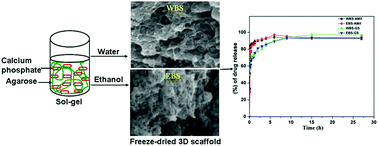Effect of solvent; enhancing the wettability and engineering the porous structure of a calcium phosphate/agarose composite for drug delivery
Abstract
Tissue engineering deals with the regeneration of tissues for bone repair, wound healing, drug delivery, etc., and a highly porous 3D artificial scaffold is required to accommodate the cells and direct their growth. We prepared 3D porous calcium phosphate ((hydroxyapatite/β-tricalcium phosphate)/agarose, (HAp/β-TCP)/agarose) composite scaffolds by sol–gel technique with water (WBS) and ethanol (EBS) as solvents. The crystalline phases of HAp and β-TCP in the scaffolds were confirmed by X-ray diffraction (XRD) analysis. The EBS had reduced crystallinity and crystallite size compared to WBS. WBS and EBS revealed interconnected pores of 1 μm and 100 nm, respectively. The swelling ratio was higher for EBS in water and phosphate buffered saline (PBS). An in vitro drug loading/release experiment was carried out on the scaffolds using gentamicin sulphate (GS) and amoxicillin (AMX). We observed initial burst release followed by sustained release from WBS and EBS. In addition, GS showed more extended release than AMX from both the scaffolds. GS and AMX loaded scaffolds showed greater efficacy against Pseudomonas than Bacillus species. WBS exhibited enhanced mechanical properties, wettability, drug loading and haemocompatibility compared to EBS. In vitro cell studies showed that over the scaffolds, MC3T3 cells attached and proliferated and there was a significant increase in live MC3T3 cells. Both scaffolds supported MC3T3 proliferation and mineralization in the absence of osteogenic differentiation supplements in media which proves the scaffolds are osteoconducive. Microporous scaffolds (WBS) could assist the bone in-growth, whereas the presence of nanopores (EBS) could enhance the degradation process. Hence, WBS and EBS could be used as scaffolds for tissue engineering and drug delivery. This is a cost effective technique to produce scaffolds of degradable 3D ceramic–polymer composites.


 Please wait while we load your content...
Please wait while we load your content...